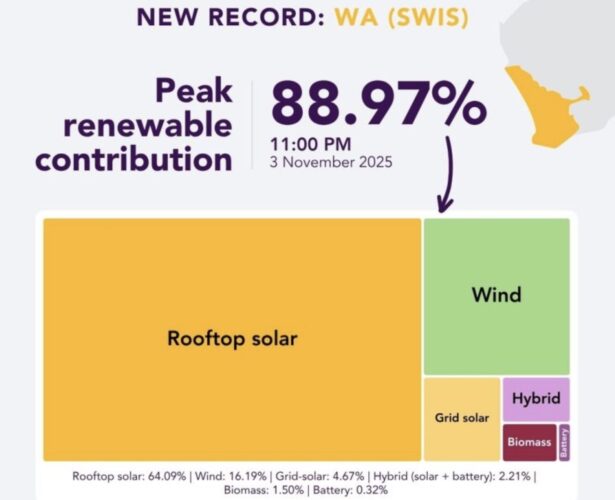Western Australia’s South West Interconnected System – the world’s biggest isolated grid – has reached a remarkable new record high of 89 per cent renewables, led by rooftop solar.
The new peak – 88.97 per cent to be precise – was reached at 11am on Monday, beating the previous record of 87.29 per cent set just a day earlier, and the previous peak of 85.36 per cent set on October 23.
“Another milestone for WA’s clean energy future,” Sanderson wrote. “It’s another strong sign of the transformation underway in our energy system as we become a renewable energy powerhouse.”
The Australian Energy Market Operator says the record share was led by rooftop solar, which accounted for 64 per cent of generation at the time. Large scale wind accounted for just over 16 per cent, with the rest from large scale solar, solar battery hybrids, biomass and battery storage.
AEMO executive general manager WA Kirsten Rose says the new record was driven by clear skies, low demand and strong wind conditions.
“From our control room, we are seeing renewables increasingly provide more than 80% of the SWIS’ electricity needs, and this will continue to grow as more of the current investment pipeline connects to the grid,” Rose said.
The new peak is remarkable because it is not so very long ago that renewable skeptics were suggesting that instantaneous shares of 20 per cent would cause the grid to collapse, the economy to fail and send everyone back to live in caves. The Nationals still believe this to be the case.
Other states have had higher renewable shares – South Australia for instance recently reached a new peak of 150 per cent of state demand. But these states can do that because they have transmission links to other states and grid and can export surplus wind and solar output.
W.A.’s SWIS has no connections to other grids, so cannot export or import. It also does not have pumped hydro, the popular go-to for grids with high levels of renewables.
What it does have is a rapidly growing fleet of big batteries, including the two biggest in Australia, one of which has only just started operations, as we report here: Australia’s second biggest battery shows signs of life, turning coal centre into massive battery bank
Those batteries play a key role in balancing the grid, boosting demand levels if AEMO deems that the share of rooftop solar is too high to manage, and storing the solar output for the evening peaks. They can also respond quickly to any grid disturbances.
W.A. plans to retire its three remaining state-owned coal generators by 2029, and the other privately owned generator is also expected to close.
However, it faces a challenge to build sufficient new wind and solar bulk supply to fill those gaps. The federal government is currently holding a W.A.-specific generation tender under its Capacity Investment Scheme program that is seeking 1.6 GW of new wind and solar capacity.
Bids close on Friday, with winners to be announced in March or April next year.
Giles Parkinson is founder and editor-in-chief of Renew Economy, and founder and editor of its EV-focused sister site The Driven. He is the co-host of the weekly Energy Insiders Podcast. Giles has been a journalist for more than 40 years and is a former deputy editor of the Australian Financial Review. You can find him on LinkedIn and on Twitter.



